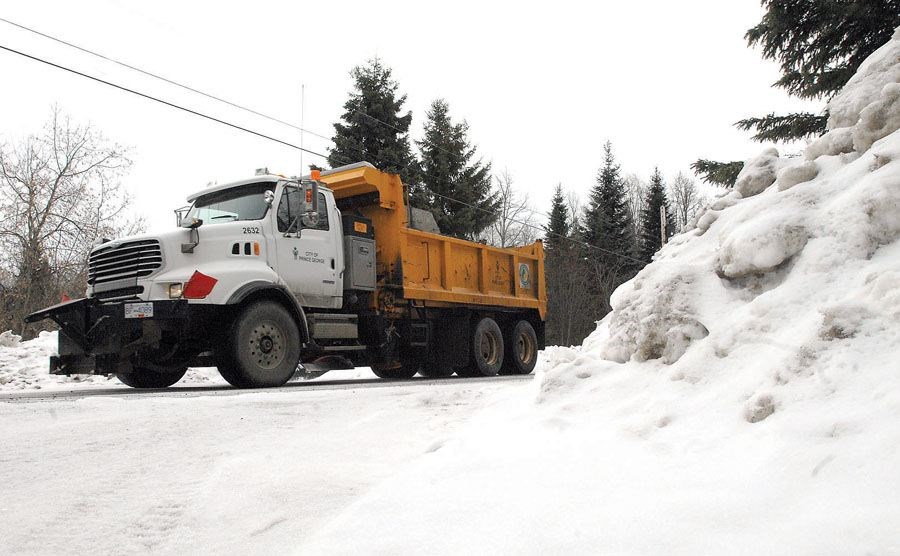The cost of keeping city streets clear of snow and ice is skyrocketing, prompting a shift in the choice of material used for road traction.
It's as plain as the dust that hung over the city last week.
Since the start of the year, city crews have stopped using fracture, a mixture of crushed rock and salt, for traction on slippery roads and are now using sand and salt exclusively for all streets outside the downtown core.
The price of fracture, which was close to $6 per tonne in 2012, has more than doubled to $13 in 2013. Dave Bradshaw, the city's manager of transportation, had no choice but make the switch to sand, which wasn't used at all for road maintenance in 2012.
"We've been using the fracture in the downtown for the last couple years to help out with the air quality," said Bradshaw.
The city considered separate bids from three suppliers of fractured rock. Rolling Mix Concrete quoted a price of about $7.50 per tonne, Kode Contracting Ltd., was offering it at $12.50 per tonne, and Inland Concrete's fracture price was $13 per tonne. Rolling Mix was forced to cut the city off in January to protect the stock it sells to private contractors at a rate higher than the bulk savings it offers the city. The city's supply services department considers in the bid process the lowest price first and if that supplier can't supply enough, it will go to the company offering the next lowest price. Bradshaw said Kode ran out of fracture as well, so the city turned to Inland Concrete, at $13 per tonne.
"You have to go with whoever has the material," said Bradshaw. "They all put in their bids as to what they will charge for supplying it, based on a guesstimate as to how much material they will go through. If you don't bring in enough, it's unfortunate for us."
Bradshaw said the city will continue its practice of buying at the lowest price once the local suppliers replenish their stock in the summer.
The city started using fractured rock in 1996 as a means of providing traction that minimized road dust. Applied after snow clearing, when the air temperature is too cold for salt to be effective, the largest particles of fracture are no larger than 12.5 millimetres and the mixture contains no silt, which tends to create dust. The larger particles of fracture bind better to slippery surfaces and don't get thrown or washed into the curbs as readily as sand or salt.
Sand costs about $6 per tonne, much cheaper to apply than salt, which costs $113 per tonne.
The city did not use any sand in 2012 for snow and ice control road maintenance, instead dumping 8,902 tonnes of fracture (mixed with two per cent added salt) and 2,195 tonnes of salt.
Last year, the city hauled 309,150 cubic metres of snow from its 670 kilometres of paved streets, down considerably from 2011, when 594,340 cubic metres of snow were cleared away. Snow clearing expenses reached $5.345 million in 2012.
Part of that budget was spent on 131,278 litres of anti-icing calcium chloride liquid, at a cost of 23 cents per litre. The solution was introduced in 2000 as a pilot project and the city immediately saw the benefits of applying it in the fall before winter weather set in. Calcium chloride lowers the freezing temperature to as low as -4 C, preventing ice from forming or roads.
If it's warm enough to apply, calcium chloride allows crews to begin sweeping earlier. It's typically applied the night before sweeping operations to help prevent overnight freezing that would limit the effectiveness of the sweepers. But if nighttime temperatures are too cold, the solution can turn streets into skating rinks.
Calcium chloride also acts as a dust suppressant and the city would have used it last week to mix with the sand already on the roads if it had been warmer at night. Because it wasn't used, the dry air conditions and constant traffic on city streets kicked up clouds of road dust that significantly raised the levels of PM10 air pollution, triggering an advisory that lasted nearly four days.
"Calcium chloride makes a big difference in dust control," B.C. Ministry of Environment air quality meteorologist Dennis Fudge. "When they started using it, we weren't issuing near as many dust advisories that spring as Quesnel, Smithers or Williams Lake were, and we're all in the same climatic zone. We noticed whenever they applied it, it made a big difference in the amount of dust that was in the air."
Bradshaw said road sweeping operations will begin over the next few weeks if temperatures will allow it. He said owners of private parking lots and the contractors who sweep road materials off those areas are required to use dust control suppression liquids to minimize dust pollution. Failure to do so could result in a $200 fine. He said residents can phone the city's bylaw services department at 250-561-7600 to report infractions.



